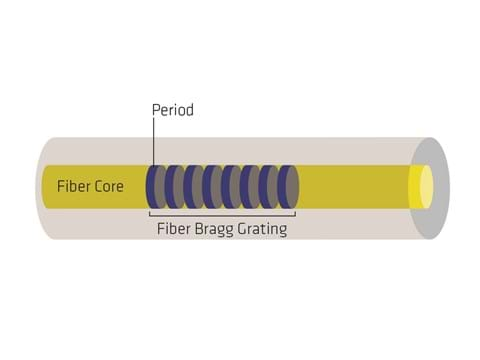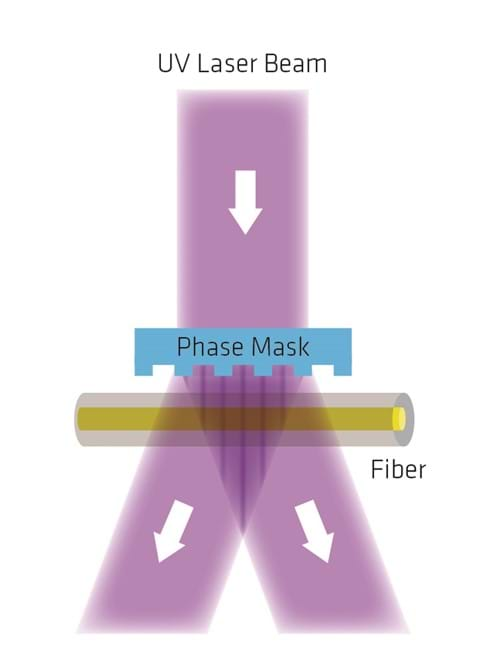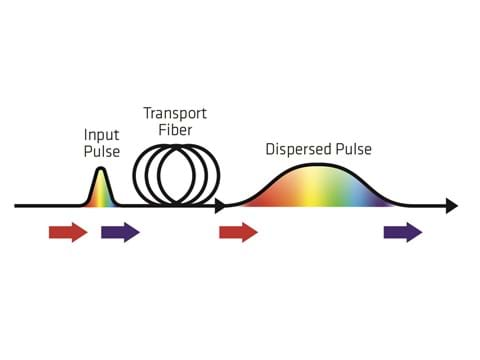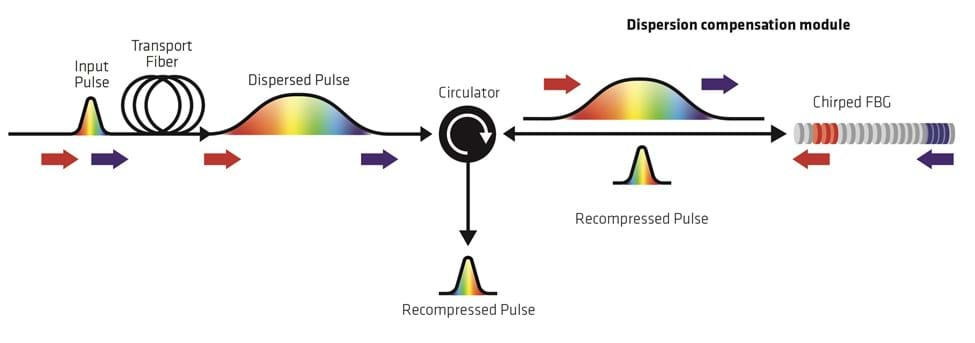Fiber Bragg Gratings
Optical fibers are an effective method to move pulses of light from one location to another efficiently and with very little loss in intensity. A fiber comprises two components. At the center of the fiber is a very small-diameter “core” with a high refractive index, which carries the light. Surrounding the core is a “cladding” with a higher refractive index that confines the light within the core. Fiber Bragg gratings are inscribed within optical fibers.

What Are Fiber Bragg Gratings?
A fiber Bragg grating (FBG) is an optical fiber in which the index of refraction within the core of the fiber changes along its length, from high-index to low-index. The modulation of the refractive index causes an FBG to act like a mirror that reflects certain wavelengths and transmits others. The wavelength that an FBG reflects depends on the spacing between the high index and low index regions within the fiber. The distance between two high-index regions within the fiber is called the “period of the FBG”, denoted as Λ. FBGs preferentially reflect light at the Bragg wavelength "λB", defined by λB = 2neffΛ, where neff is the average effective refractive index of the fiber. The strength of the reflection depends on how large the index modulation is.
This modulation of the refractive index within an FBG can be a steady periodic change or a variable “quasi-periodic” change. If an FBG contains regions with different periods, a single optical fiber can contain multiple “mirrors,” causing different wavelengths of light to reflect from different positions along the fiber. The change in the period of the index modulation along the length of the fiber does not need to be abrupt. FBGs that feature a period that changes smoothly along the fiber length are called “chirped” FBGs or simply CFBGs. CFBGs can have elaborate period profiles.

How are Fiber Bragg Gratings Made?
FBGs are created by “writing” patterns into the core, changing the index of refraction along the length of the fiber. The most common way to produce FBGs is to project extremely high-resolution ultraviolet (UV) patterns onto an optical fiber. UV light causes the index of refraction to increase in the exposed regions and remain unchanged in the unexposed regions.
There are a few different ways to create the UV pattern used to write the desired pattern into the core of the fiber. One method is to project two UV beams simultaneously onto the fiber, creating a high-resolution interference pattern. For more complicated chirped patterns, it is more common to place a transparent filter, called a “phase mask,” between the UV light and the fiber. The phase mask redistributes the UV light into high and low brightness areas, which then become high and low index regions within the core of the fiber.

What Is Chromatic Dispersion?
Although a light pulse may be associated with a specific wavelength, light pulses themselves are not “monochromatic”—they are composed of a narrow range of wavelengths around a center wavelength. As a light pulse travels through an optical fiber, it begins to widen because of a process known as “chromatic dispersion.” Dispersion causes different light wavelengths to travel at slightly different speeds. Specifically, blue light (short wavelength) travels faster than red light (long wavelength). If left uncorrected, dispersion limits how sharp, or “fast,” a pulse can be. For telecommunications, dispersion also limits how long a fiber can be before separate pulses begin to overlap.
Pulse Stretching and Compression with Fiber Bragg Gratings
FBGs and CFBGs are particularly valuable because these specially modified optical fibers can compensate or exaggerate chromatic dispersion by reflecting different wavelengths at different positions along the FBG. Specifically, a CFBG can be designed so that slower-moving red light reflects sooner or later than the faster moving blue light. If the red light reflects earlier, then the time-delay allows the red light to catch up to the blue light, creating a shorter pulse. Conversely, if the red light reflects later than the blue light, then the pulse widens even further.

For decades, FBGs have been used as sensors in applications such as strain, temperature and pressure sensing. Even though they are still widely used for these applications, TeraXion’s expertise resides in designing and manufacturing leading-edge FBGs and CFBGs.
These FBGs and CFBGs are used in multiple different applications, ranging from industrial lasers to optical communication networks. Here are a few examples of applications in which TeraXion’s FBGs are used:
- Ultrafast lasers with the shortest and least noisy pulses on the market
- High-efficiency oscillators that reduce the size and weight of multi-kW lasers
- High-speed, long-reach direct detection optical communication networks
- Precision lidar systems
- Radio-frequency (RF) over fiber



